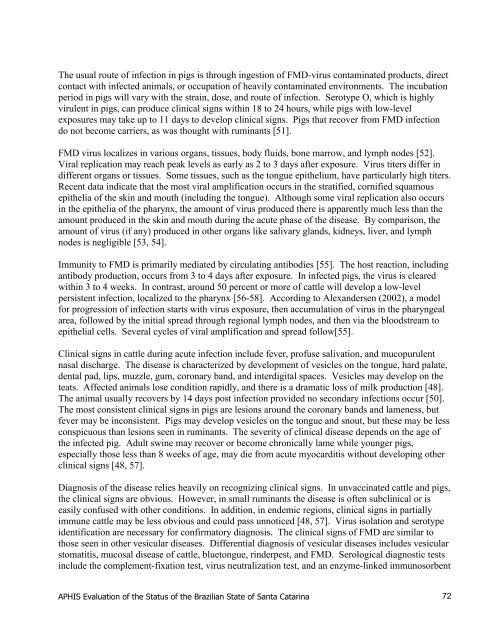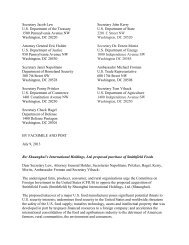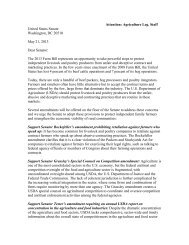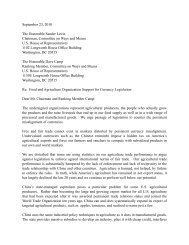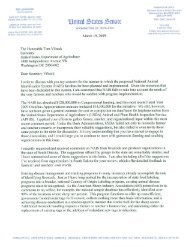Exhibit 8, 100416 Brazil FMD Risk Evaluation - R-Calf
Exhibit 8, 100416 Brazil FMD Risk Evaluation - R-Calf
Exhibit 8, 100416 Brazil FMD Risk Evaluation - R-Calf
You also want an ePaper? Increase the reach of your titles
YUMPU automatically turns print PDFs into web optimized ePapers that Google loves.
The usual route of infection in pigs is through ingestion of <strong>FMD</strong>-virus contaminated products, direct<br />
contact with infected animals, or occupation of heavily contaminated environments. The incubation<br />
period in pigs will vary with the strain, dose, and route of infection. Serotype O, which is highly<br />
virulent in pigs, can produce clinical signs within 18 to 24 hours, while pigs with low-level<br />
exposures may take up to 11 days to develop clinical signs. Pigs that recover from <strong>FMD</strong> infection<br />
do not become carriers, as was thought with ruminants [51].<br />
<strong>FMD</strong> virus localizes in various organs, tissues, body fluids, bone marrow, and lymph nodes [52].<br />
Viral replication may reach peak levels as early as 2 to 3 days after exposure. Virus titers differ in<br />
different organs or tissues. Some tissues, such as the tongue epithelium, have particularly high titers.<br />
Recent data indicate that the most viral amplification occurs in the stratified, cornified squamous<br />
epithelia of the skin and mouth (including the tongue). Although some viral replication also occurs<br />
in the epithelia of the pharynx, the amount of virus produced there is apparently much less than the<br />
amount produced in the skin and mouth during the acute phase of the disease. By comparison, the<br />
amount of virus (if any) produced in other organs like salivary glands, kidneys, liver, and lymph<br />
nodes is negligible [53, 54].<br />
Immunity to <strong>FMD</strong> is primarily mediated by circulating antibodies [55]. The host reaction, including<br />
antibody production, occurs from 3 to 4 days after exposure. In infected pigs, the virus is cleared<br />
within 3 to 4 weeks. In contrast, around 50 percent or more of cattle will develop a low-level<br />
persistent infection, localized to the pharynx [56-58]. According to Alexandersen (2002), a model<br />
for progression of infection starts with virus exposure, then accumulation of virus in the pharyngeal<br />
area, followed by the initial spread through regional lymph nodes, and then via the bloodstream to<br />
epithelial cells. Several cycles of viral amplification and spread follow[55].<br />
Clinical signs in cattle during acute infection include fever, profuse salivation, and mucopurulent<br />
nasal discharge. The disease is characterized by development of vesicles on the tongue, hard palate,<br />
dental pad, lips, muzzle, gum, coronary band, and interdigital spaces. Vesicles may develop on the<br />
teats. Affected animals lose condition rapidly, and there is a dramatic loss of milk production [48].<br />
The animal usually recovers by 14 days post infection provided no secondary infections occur [50].<br />
The most consistent clinical signs in pigs are lesions around the coronary bands and lameness, but<br />
fever may be inconsistent. Pigs may develop vesicles on the tongue and snout, but these may be less<br />
conspicuous than lesions seen in ruminants. The severity of clinical disease depends on the age of<br />
the infected pig. Adult swine may recover or become chronically lame while younger pigs,<br />
especially those less than 8 weeks of age, may die from acute myocarditis without developing other<br />
clinical signs [48, 57].<br />
Diagnosis of the disease relies heavily on recognizing clinical signs. In unvaccinated cattle and pigs,<br />
the clinical signs are obvious. However, in small ruminants the disease is often subclinical or is<br />
easily confused with other conditions. In addition, in endemic regions, clinical signs in partially<br />
immune cattle may be less obvious and could pass unnoticed [48, 57]. Virus isolation and serotype<br />
identification are necessary for confirmatory diagnosis. The clinical signs of <strong>FMD</strong> are similar to<br />
those seen in other vesicular diseases. Differential diagnosis of vesicular diseases includes vesicular<br />
stomatitis, mucosal disease of cattle, bluetongue, rinderpest, and <strong>FMD</strong>. Serological diagnostic tests<br />
include the complement-fixation test, virus neutralization test, and an enzyme-linked immunosorbent<br />
APHIS <strong>Evaluation</strong> of the Status of the <strong>Brazil</strong>ian State of Santa Catarina 72


